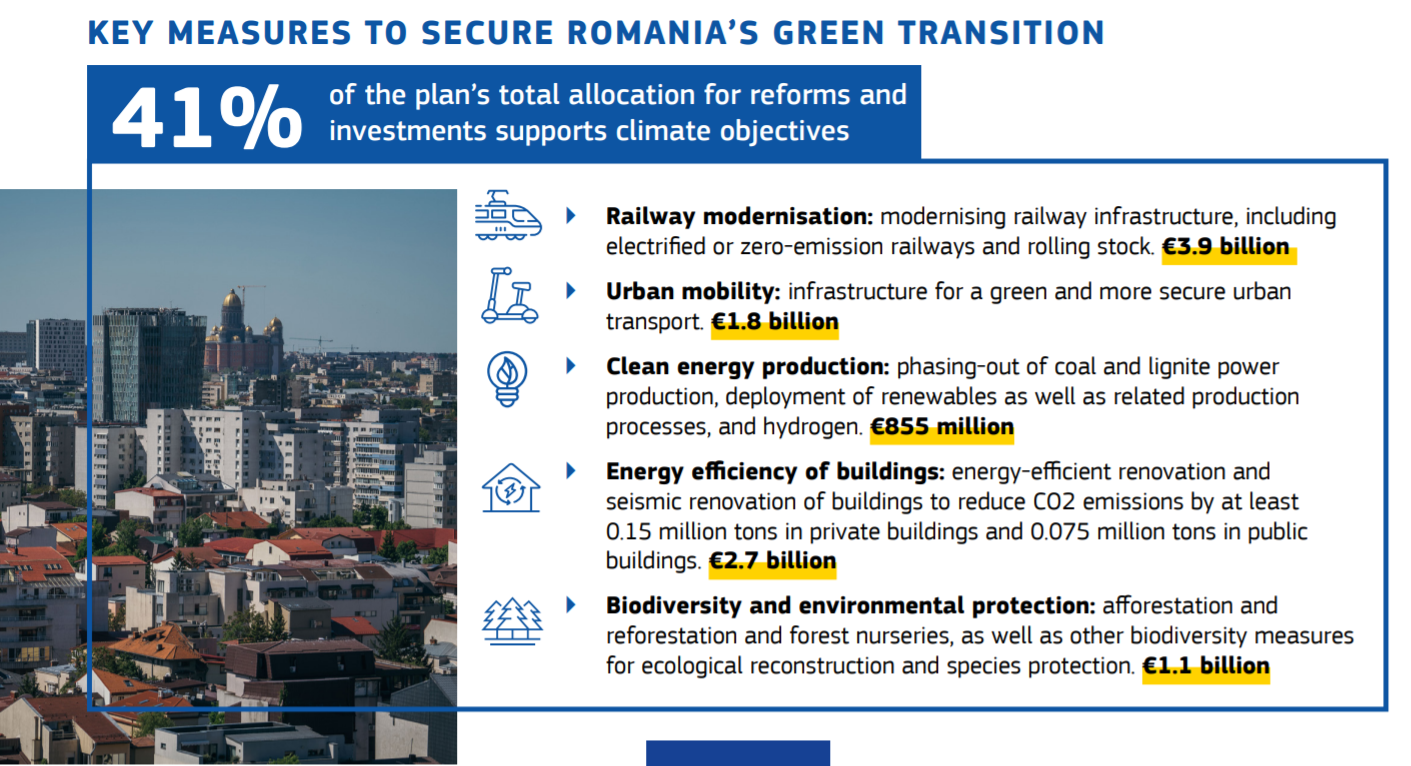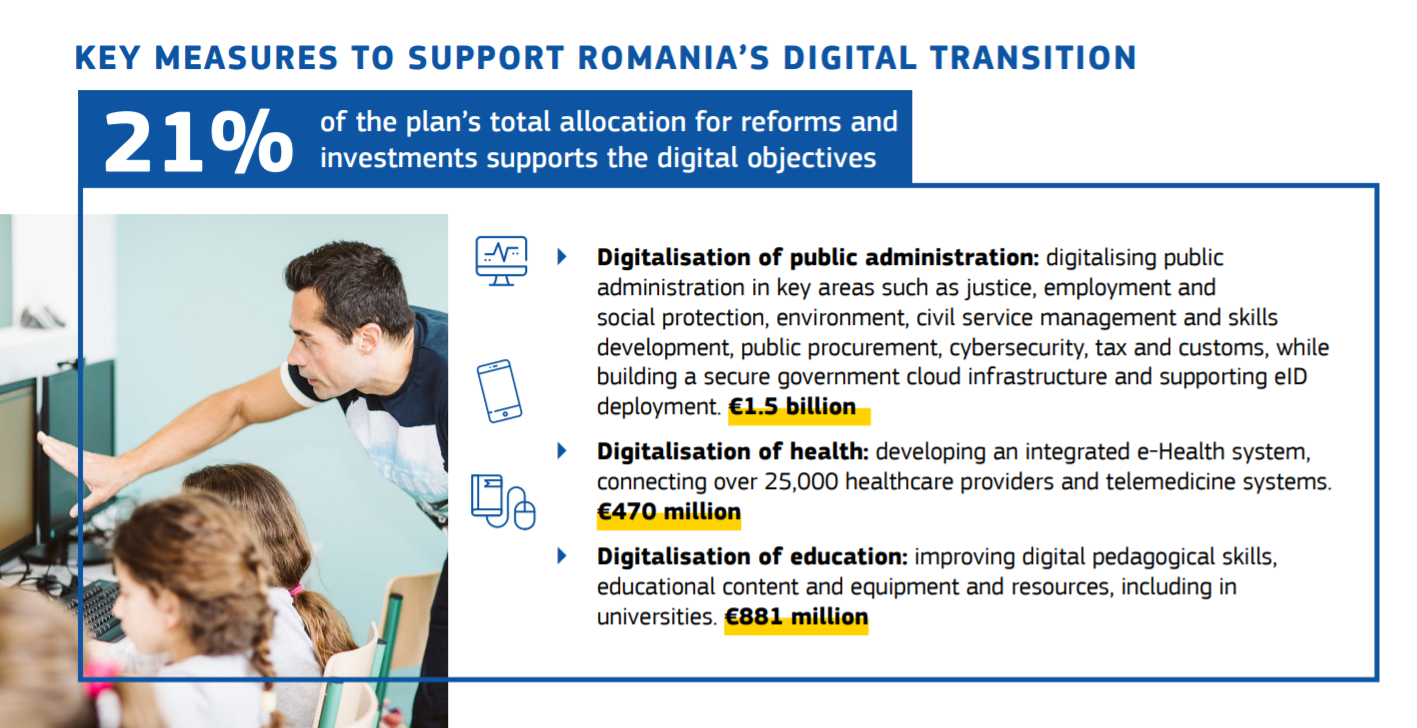How did the Commission assess Romania’s recovery and resilience plan?
The Commission is assessing the recovery and resilience plans based on eleven criteria set out in the Recovery and Resilience Facility (RRF) Regulation. The 11 criteria require an assessment of whether:
- the measures have a lasting impact;
- the measures address the challenges identified in the country-specific recommendations or a significant subset of them;
- the milestones and targets which allow for monitoring the progress with the reforms and investments are clear and realistic;
- the plans meet the 37% climate expenditure target and the 20% digital expenditure target;
- the plans respect the do no significant harm principle;
- the plans provide an adequate control and audit mechanism and set out the plausibility of the costing information.
The Commission has summarised its assessment in the proposal for the Council Implementing Decision. The accompanying staff-working document provides detailed documentation on the assessment.
Does Romania’s recovery and resilience plan effectively support the green transition?
The Romanian plan’s contribution to the green transition amounts to 41% of its total allocation of €29.2 billion. This exceeds the minimum of 37% required by the RRF Regulation.
The plan has a strong focus on the green transition, with flagship reforms on the phasing-out of coal and the decarbonisation of road transport. The reforms and investments are expected to significantly decarbonise the energy sector and unlock the potential for renewables deployment. The strong focus on energy efficiency of private and public buildings, digitalisation of road and rail transport and the deployment of electric charging infrastructures, climate change adaptation and circular economy, will also facilitate the green transition in all sectors of the economy.
With several reforms and investments in the forestry sector, such as the adoption of the National Forest Strategy and the ecological reconstruction of habitats and the conservation of species, the Plan is also expected to contribute to biodiversity conservation and restoration.
Does Romania’s recovery and resilience plan effectively contribute to the digital transition?
The Romanian plan’s contribution to the digital transition amounts to 21% of its total allocation of €29.2 billion. This exceeds the minimum of 20% required by the RRF Regulation.
The plan is expected to address digitalisation challenges related to the public administration by proposing a comprehensive package of measures to provide secure, interoperable, cost-efficient and fast user-centric services for citizens and businesses. The deployment of the electronic identity card is expected to facilitate the digital interaction between public/private entities and citizens.
The business sector is expected to benefit from significant investments which are expected to accelerate the digitalisation of both SMEs and large companies with a focus on the development and adoption of advanced technologies. The plan includes a reform to streamline, simplify and fully digitalise business-related regulatory requirements. In addition, participation in a multi-country project is planned to be implemented as an Important Project of Common European Interest (IPCEI) on microelectronics.
As regards education, reforms include standards for ensuring the quality of online educational activities and the alignment of the educational system to DigComp, the European framework for digital competences for students. Investments will support the development of training courses for digital literacy, grants for informatics laboratories and smart hubs, the development of open educational resources and schemes for the digitalisation of universities.
Does the recovery and resilience plan represent a balanced response to the economic and social situation of Romania?
The Romanian plan represents a comprehensive and adequately balanced response to Romania’s economic and social situation, thereby contributing appropriately to all six pillars referred to in the RRF Regulation.
The plan follows a holistic approach to achieve recovery and increase potential growth, while enhancing socio-economic and institutional resilience. The plan contains mutually-reinforcing and coherent reforms and investments that refer to policy areas of EU relevance structured around the six pillars.
The plan contains a series of measures that are expected to directly or indirectly support private investments, including for SMEs, increase the capacity of the country to attract investment and create new businesses and jobs. The plan also aims to reinforce fiscal sustainability through important reforms of the tax administration, the tax framework, the management of public expenditure and the pension system. The plan also envisages strengthening social and territorial cohesion through structural measures on the labour market and important reforms and investments targeting both urban and rural development, which are expected to reduce territorial disparities at regional, intra-regional and intra-county level.
The proposed reforms and investments are expected to strengthen the overall resilience of the health system, including through its digitalisation. Finally, measures in the plan aim to help the next generations mainly by addressing challenges in terms of quality, equity and infrastructure in the educational system. The upgrade of school and university infrastructure in urban and rural areas, the digitalisation of education and a system of grants to reduce the drop-out rate are the main measures to address these challenges.
Do the reforms presented by Romania effectively address a significant part of the country-specific recommendations issued to it in the context of the European Semester?
The Romanian plan includes an extensive set of mutually reinforcing reforms and investments that contribute to effectively addressing a significant subset of the economic and social challenges outlined in the country-specific recommendations addressed to Romania. Notably, reforms and investments included in the plan are expected to contribute in the areas of sustainability of public finances and the pension system, healthcare, public administration, business environment, education, and green and digital transition.
The full digitalisation of the tax administration and gradual phase out of excessive tax incentives, as well as an improved fiscal framework, will contribute to the sustainability of public finances. The plan also aims at ensuring the sustainability and fairness of the public pension system. Healthcare reforms, accompanied by digitalisation investments, are expected to improve the access to and the cost-efficiency and resilience of the healthcare system.
Evidence-based decision making, long-term planning and public consultations, and measures aimed at improving the public procurement process, reinforcing the effectiveness of the judicial system and fighting corruption will contribute to improving the quality and effectiveness of the public administration. Reforms on minimum wage setting, on strengthening the corporate governance of state-owned enterprises and on social dialogue also address long-standing country-specific recommendations. The plan also introduces a unitary, inclusive and quality early-childhood education and care system accompanied by investments in childcare.
For More Information
Press release: European Commission endorses Romania’s €29.2 billion recovery and resilience plan

